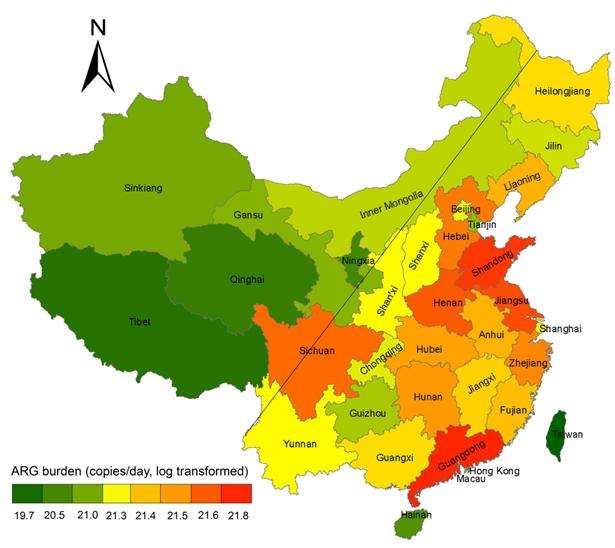Scientists map the distribution of antimicrobial resistance across Chinese major cities

The global emergence of antimicrobial resistance threatens therapies that combat bacterial pathogens. Resistance genes detected in city sewage may serve as a proxy for the resistance burden of their urban populations. Professor ZHU Yongguan from the Institute of Urban Environment of the Chinese Academy of Sciences and his collaborators recently conducted a nationwide survey of antimicrobial resistance elements in China's urban sewage and showed that the distribution of antimicrobial-resistant genes (ARG) was characterized by the well-known Hu Huanyong line, which delineates a striking difference in the distribution of China's population. This demonstrated that the emergence of ARGs is driven by human activity.
A total of over 116 urban sewage samples from 32 wastewater treatment plants across 17 Chinese major cities were investigated in this study. Urban sewage was found to possess high levels of antimicrobial resistance genes—around 1011 to 1012 copies per liter. The occurrence of antimicrobial resistance in urban sewage has a distinct seasonal pattern and the antibiotic resistome is extensively shared in urban sewage across China.
This study revealed that municipal sewage harbors diverse and abundant resistance genes. In total, 381 different resistance genes conferring resistance to almost all antibiotics were detected and these genes were extensively shared across China, with no geographical clustering, highlighting that municipal sewage could be a major conduit for transferring antibiotic resistance genes into the environment.
Adults harbor significant quantities of resistance genes in their gut microbiomes, primarily owing to antibiotic usage in infection treatment. In particular, the frequent presence of multi-antibiotic resistant "superbugs" in human feces predicts a return to the pre-antibiotic era, where a growing number of infections can no longer be treated using the current arsenal of drugs.
Urban sewage is a catchment receiving antibiotic-resistant bacteria from the gastrointestinal tracts of tens to hundreds of thousands of urban residents. The antimicrobial resistance distribution detected in urban sewage can serve as a proxy for the resistance burden map of their urban populations. The research data demonstrated that urban sewage is potentially a major conduit for dissemination of anthropogenically derived antibiotic resistance into various environmental compartments.
More information: Jian-Qiang Su et al, Metagenomics of urban sewage identifies an extensively shared antibiotic resistome in China, Microbiome (2017). DOI: 10.1186/s40168-017-0298-y


















